Oyster mushrooms: self-cultivation and care in the country
Growing mushrooms is much more profitable than vegetables. Mushrooms do not require special care and no technological costs. Having a country house and a plot, you can turn into a successful mushroom grower. To begin with, a small growing area will be enough, then you can gradually expand your open spaces.
Content:
- Growing oyster mushrooms in the country
- Fruiting and care
- Using oyster mushrooms
- Useful tips for growing mushrooms
Growing oyster mushrooms in the country
The science of mushrooms is called mycology, and you don't need to be an expert in it to succeed in growing oyster mushrooms. Growing it is quite simple and straightforward, if you carefully follow all the rules and tips. To begin with, you will need to acquire a stock of oyster mushroom mycelium. Mycelium can be purchased from a specialized mushroom growing company.
For the first experiment, you can buy a kilogram of mycelium, which will result in about 3 kg of mushrooms. This is quite enough for an initial acquaintance with the procedure for growing oyster mushrooms. The mycelium should be stored in the refrigerator at a temperature of 2-4 degrees.
An important step in growing oyster mushrooms is the preparation of the substrate:
- The optimal raw material for the preparation of the substrate is wheat or barley straw, buckwheat husk, sunflower husk, corn stalks and the cob.
- Growing is more difficult on sawdust or shavings of deciduous trees.
- Raw materials must be clean and free of mold. It needs to be cooked almost 10 kg, then crushed into 4-5 cm portions.
- Heat treatment will be required to prevent contamination of the substrate. To achieve this, you need to pour the substrate into a bowl and fill it with water. Cook for about two hours, drain the water and cool the mixture to 25 degrees. The substrate must be moist. If you squeeze it in your hand, then water should not flow from it, only a few drops are allowed.
Oyster mushrooms can be successfully grown in polyethylene. You will need two bags that can hold up to 5 kg of substrate. But, before that, the bags must be disinfected with a 102% solution of bleach. After placing the substrate in the bag, tie the latter tightly. The next day you need to pasteurize. Place the bags in a pot of water and boil for a couple of hours. This concludes the preliminary preparations.
After the substrate has cooled to 25 degrees, with a disinfected knife you need to make slots in the bag and add a teaspoon of mycelium there to each slot.
Then seal the slots with tape. For a couple of weeks, the bags are placed in ventilated rooms with a temperature of about 20 degrees. If all the rules have been followed, then after three to four days you can see the appearance of a white mycelium.
Fruiting and care
During the fruiting period, you will need eight hours of lighting with artificial lamps, a high percentage of humidity, frequent ventilation and a temperature not higher than 15 degrees.
To create high humidity, you can spray walls and flooring with water, but the water should in no way get on the substrate.
If all norms are met, fungi will appear within two weeks from these slots. To prevent the remnants of fruiting mushroom bodies from rotting inside, it is better to twist the mushrooms rather than cut them.
The substrate can be used to grow up to four oyster mushroom harvests. As a place for growing, you can use a loggia, basement, attics, etc. Oyster mushrooms do not like direct sunlight, so it is better to use darkened places. Compliance with a normal microclimate will yield a yield of 25 to 40% of the weight of the entire substrate.
Harvesting:
- It is better to harvest 5-6 days after the formation of the mushrooms.
- Optimally, the head should have a diameter of 40-100 mm, the stem 10-40 mm.
- At the very beginning of its development, the cap of the fungus is painted in a dark color, later it becomes ash-gray, and only at the end it sharply discolors.
- If the mushroom overripe, the cap begins to break, the leg hardens.
- The commercial appearance deteriorates, and with it all the taste and nutritional properties fall.
- You need to store fresh mushrooms at 0-5 degrees above zero for a week, and for about 6 hours at a temperature of about 20 degrees above zero.
- It is not recommended to selectively cut mushrooms! In general, cutting the crop should be neat and unhurried so as not to damage the mycelium.
- With the onset of cold weather, you need to cover the beds of mushrooms with straw if they are grown outdoors.
Some of the summer residents have been successfully building a business on growing oyster mushrooms for a rather long time. High demand and minimal growing costs bring tangible profits.
Using oyster mushrooms
Oyster mushroom has excellent taste and nutritional properties. Many delicious dishes can be prepared from oyster mushrooms. It should be noted that oyster mushrooms do not need to be soaked for a long time, you just need to rinse thoroughly.
Oyster mushrooms are often frozen, dried, pickled, salted, and, of course, used fresh.
From August to September, you can pamper yourself and your family with fried oyster mushrooms or delicious soups. If you combine mushrooms with vegetables, you can get great stews, pies, pancakes and many other delicious dishes. Caviar from oyster mushrooms, carrots and onions is especially popular. You can delight guests in two lights by preparing several oyster mushroom dishes at once.
These mushrooms rich in vitamins and elementsnecessary for the normal functioning of the human body. In addition, they will delight women who are watching their weight with their low calorie content.
Useful tips for growing mushrooms
If the cultivation of oyster mushrooms will take place indoors, then it must first be disinfected with a solution of bleach. This is done for prevent the development of diseases and the appearance of all kinds of pests.
Pest and disease control:
- Logs must be cleaned of mold, cobwebs, etc. It is much better to use young wood. Before growing in the garden, the log must be kept upright. It is better not to use the equipment that is usually used when working with mushrooms.
- If, when growing oyster mushrooms, mold is found, then a large amount of table salt must be applied to the place of its development.
- Potent poisons are used when mosquitoes, flies or any other insects that harm the fungi are found. This is especially true when growing large oyster mushroom plantations.
When harvesting, it is best to use a sharp stainless steel knife. Parts of oyster mushrooms that are underground are prohibited from pulling out or moving. It is better to store them in a container in the refrigerator. Under normal conditions, mushrooms can be stored for a long time.
Under natural conditions, oyster mushrooms grow better on dead trees.
But, it is best to harvest a substrate based on bran, straw or seed husks. In addition, such substrates are much better suited for growing oyster mushrooms.
In addition to the fact that oyster mushrooms do not require special care, you do not have to spend a lot of effort and finances, as oyster mushrooms are also an incredibly valuable dietary product.Oyster mushrooms contain quickly digestible proteins and essential amino acids, fats, carbohydrates, vitamins and various minerals. Therefore, such a business will bring not only profit, but also pleasure!
More information can be found in the video.



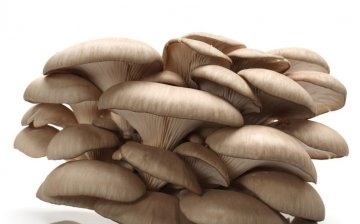
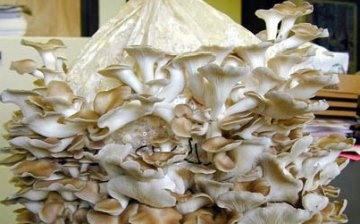
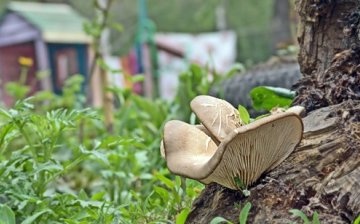
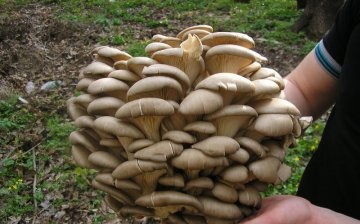






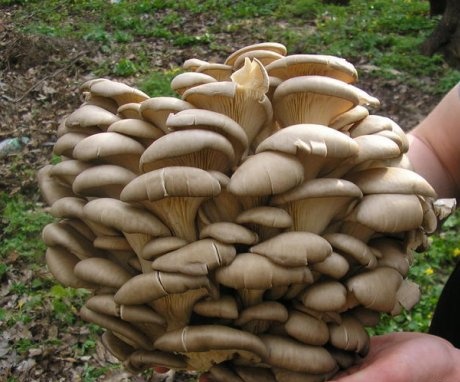
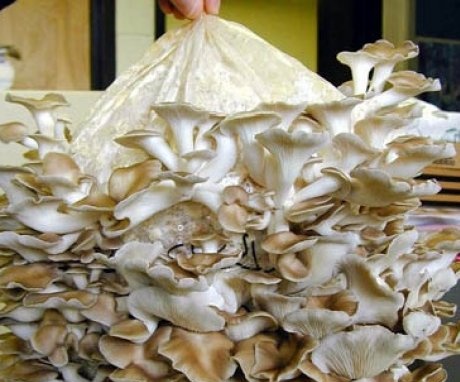

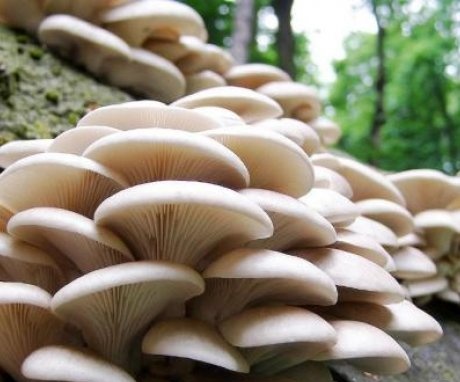
We tried to grow oyster mushrooms like mushrooms on stumps in the village in the garden, and there, in the cherry orchard, we laid a plot with stumps and mushrooms. We did not succeed. Probably little watered and the whole mycelium has dried out corny. It's a pity...
Probably all the same, "the game is worth the candle" and the cultivation of such mushrooms both for the family table and for business is great. But here, like you, mushrooms do not grow in the country. Most likely they belong in the forest.
Usually oyster mushrooms are not whimsical and are easy to grow on their own, my uncle managed to do it, moreover, he even got porcini mushrooms. Unfortunately, he is not doing this now.
There was an experience of growing oyster mushrooms in the country and the experience was very successful. From the old tree that I cut down, I left a stump a little more than a meter high. He made notches in us (deep) and hammered them with black soil. I sowed oyster mushroom mycelium into this black soil and that's it! Maybe watered a couple of times. I took two crops over the summer.